Roman Art History - Slide Identification
1/41
There's no tags or description
Looks like no tags are added yet.
Name | Mastery | Learn | Test | Matching | Spaced |
|---|
No study sessions yet.
42 Terms
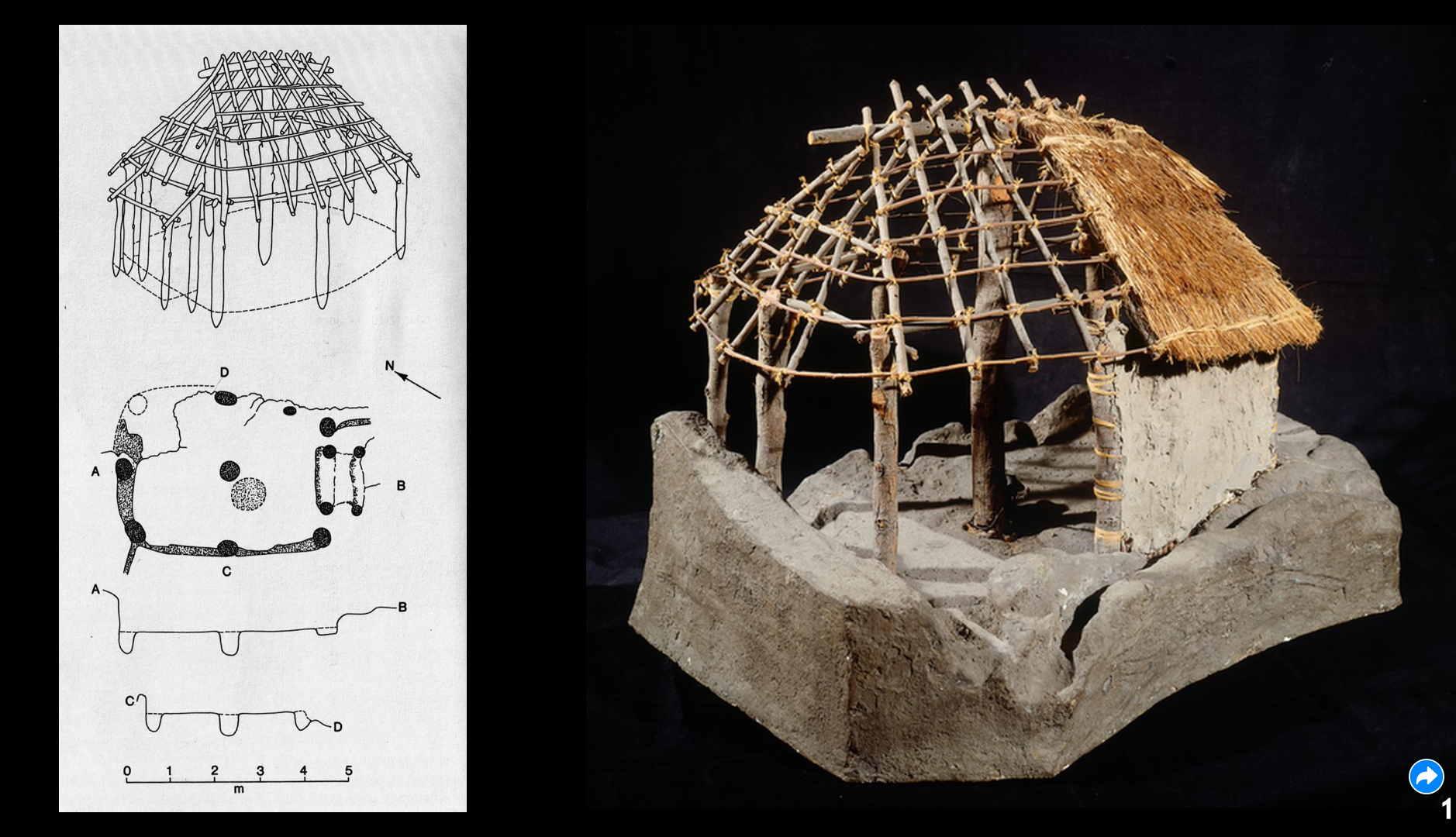
The Casa Romuli (what it would have looked like), 9th-8th centuries BCE, wattle and daub; located on the Palatine Hill; kept on the hill for centuries as both homage to Rome’s history/founder and as a marker for its progress
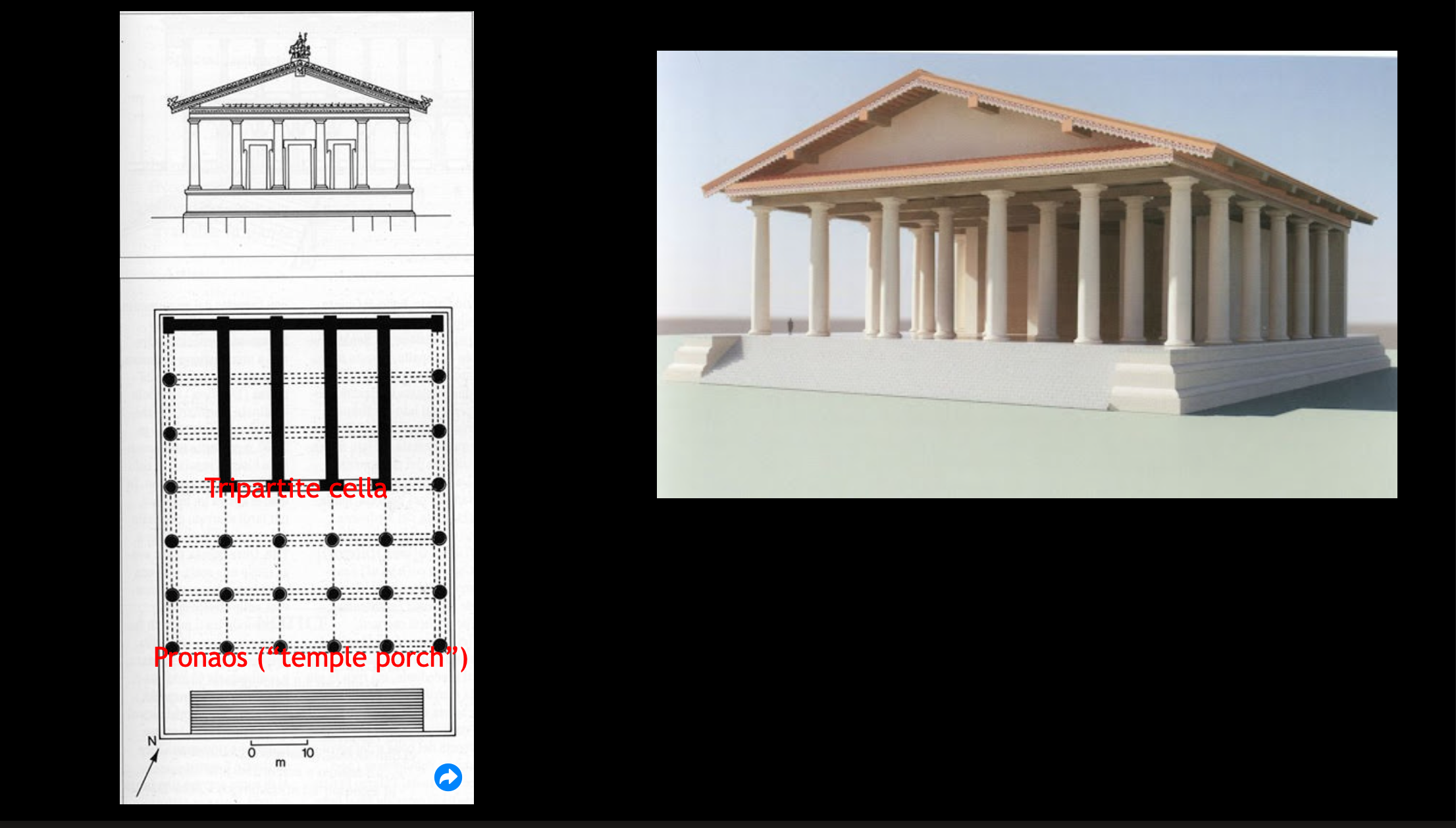
The Temple of Jupiter Optimus Maximus (Jupiter Best and Greatest), the most important temple in Ancient Rome; constructed on the Capitoline Hill in the late 6th century BCE; wood and mud brick; built in the Etruscan style; houses Jupiter, Juno, and Minerva in the tripartite cella
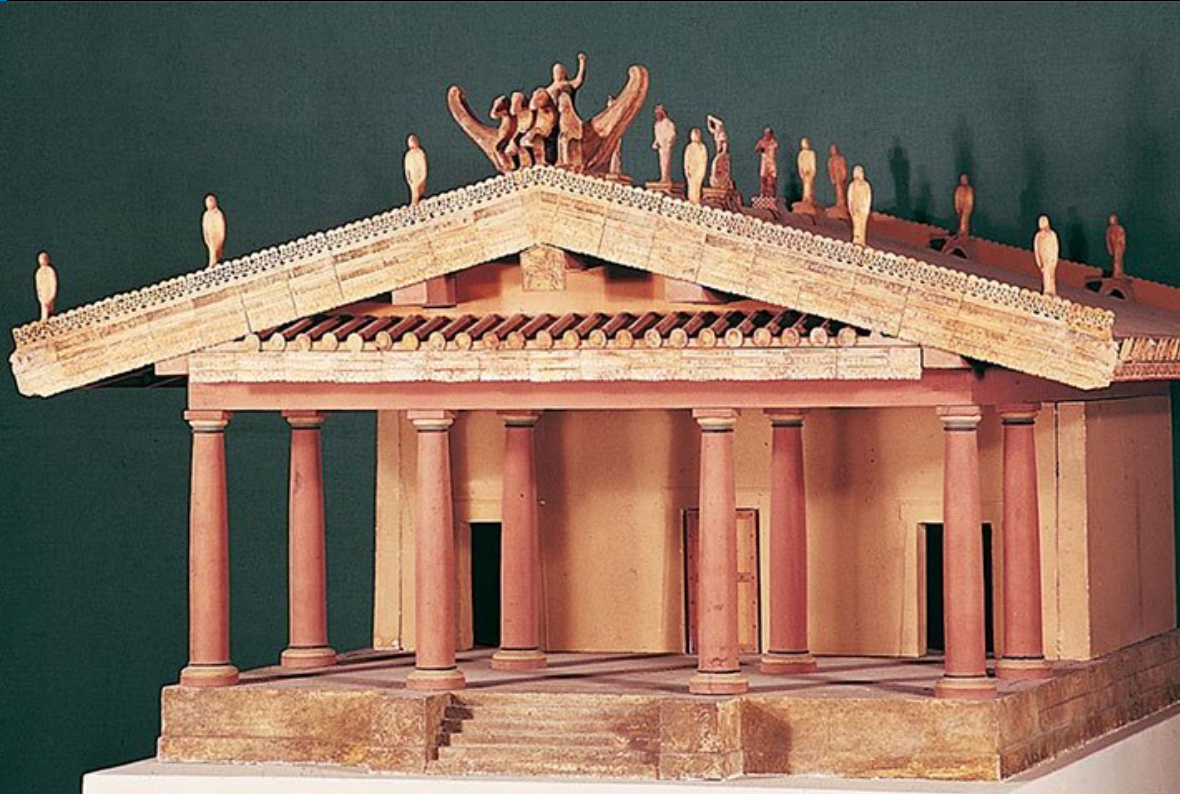
Etruscan Temple of Portonaccio (from Veii) 6th c. BCE; Etruscan architecture such as this influenced the Roman Temple of Jupiter Optimus Maximus
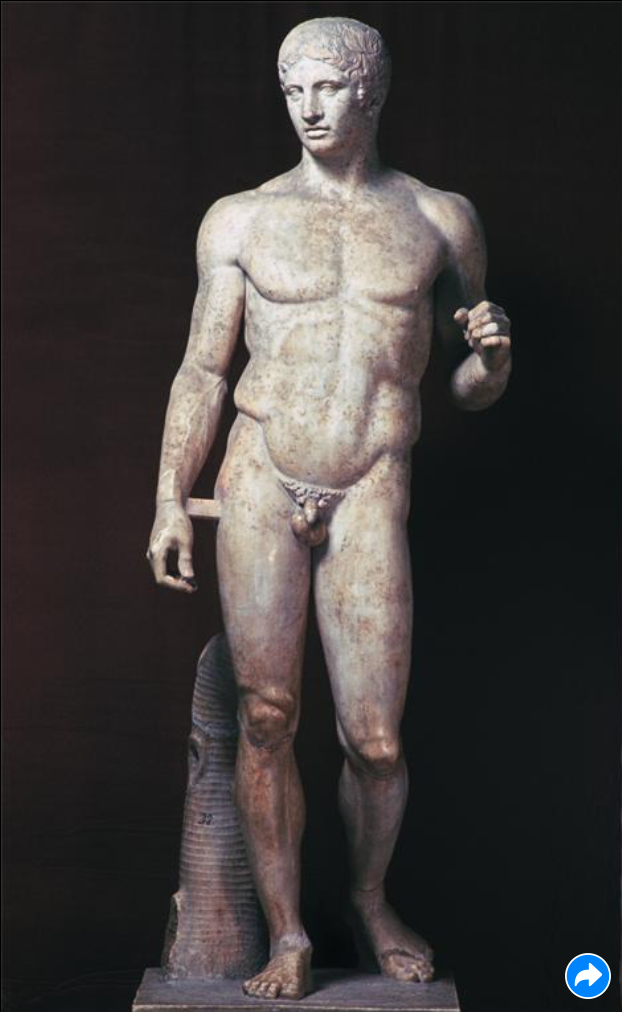
Doryphotos (Spear Bearer), marble copy (Roman) of a bronze original (Greek) by Polykleitos, ca. 450 BCE; emblematic of the idealized body and virtues of the Greek classical period as well as Greek influence on Roman art and culture; contrapposto stance to create realistic movement
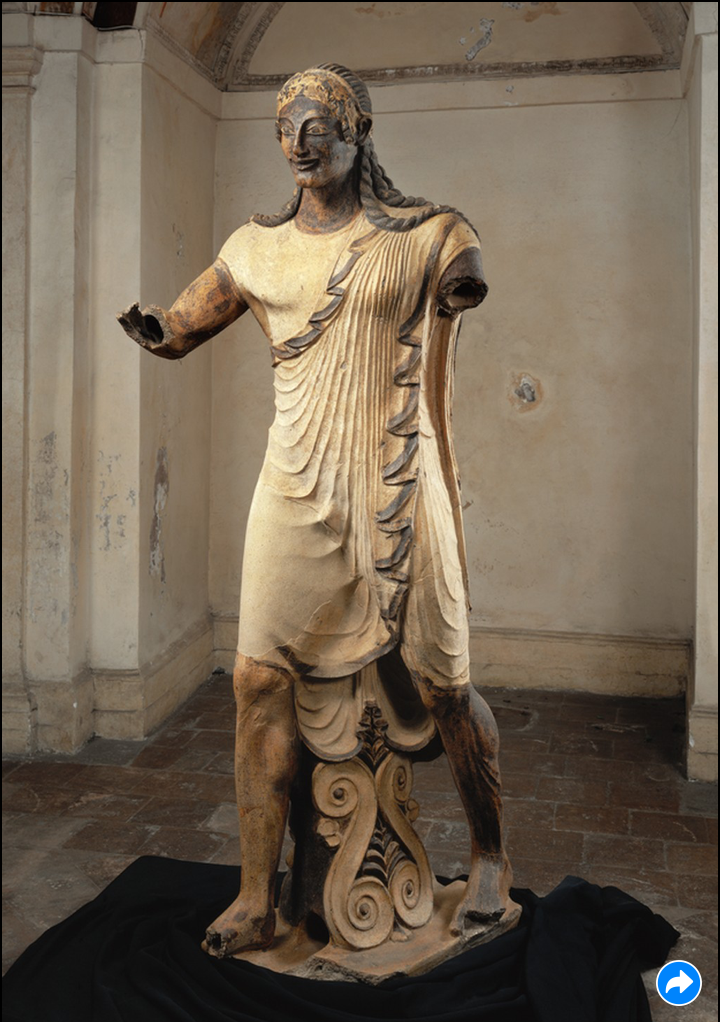
Apollo of Portonaccio/Veii, Etruscan, 510 BCE, terracotta.
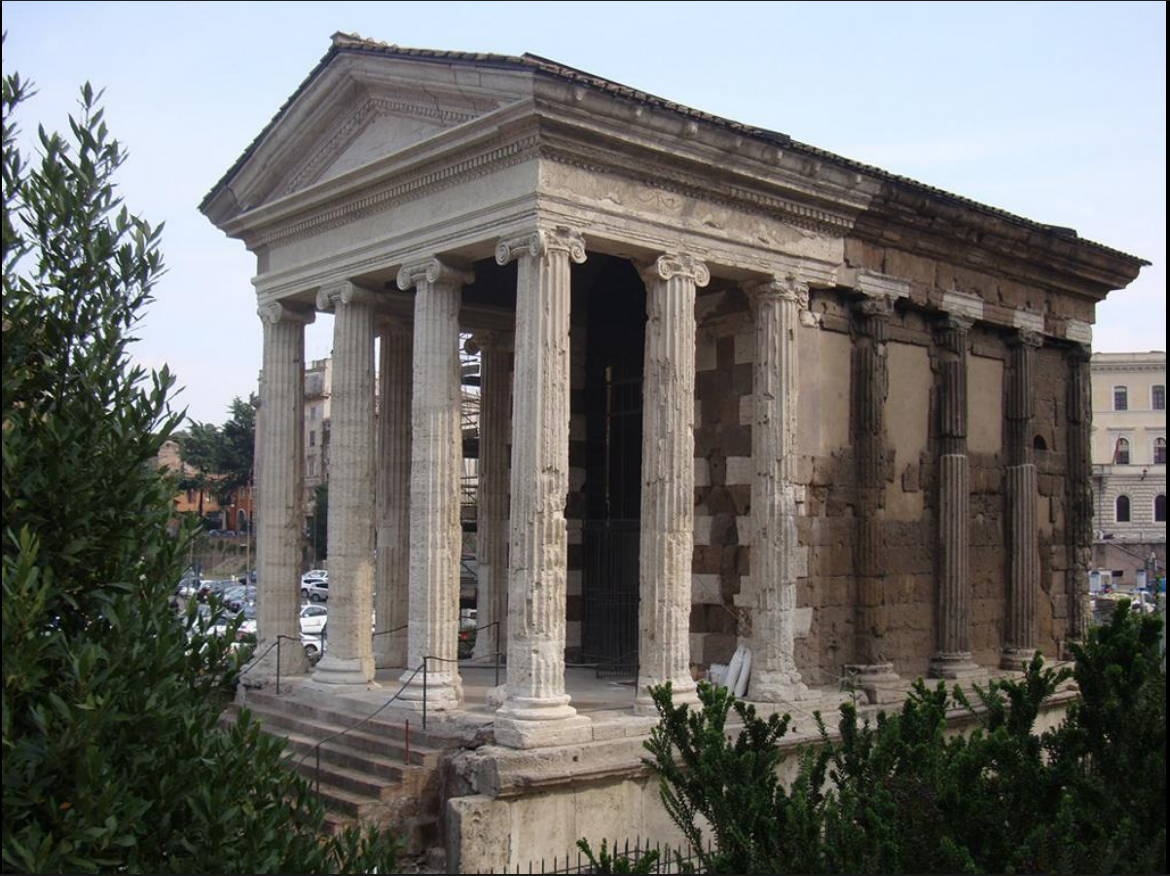
Temple of Portunus, Rome, 120-80 BCE, tuff, travertine, and stucco; located by the Forum Boarium overlooking the Tiberine port; dedicated to Portunus, a gateway god (keys, doors, livestock); example of what a victory temple may have looked like––pseudoperipteral columns; fusing of Etruscan + Greek styles = tufa in the back and travertine facade / brick columns with stucco painted white to look like marble; contained colossal marble head of Fortuna

Temple of Portunus plan
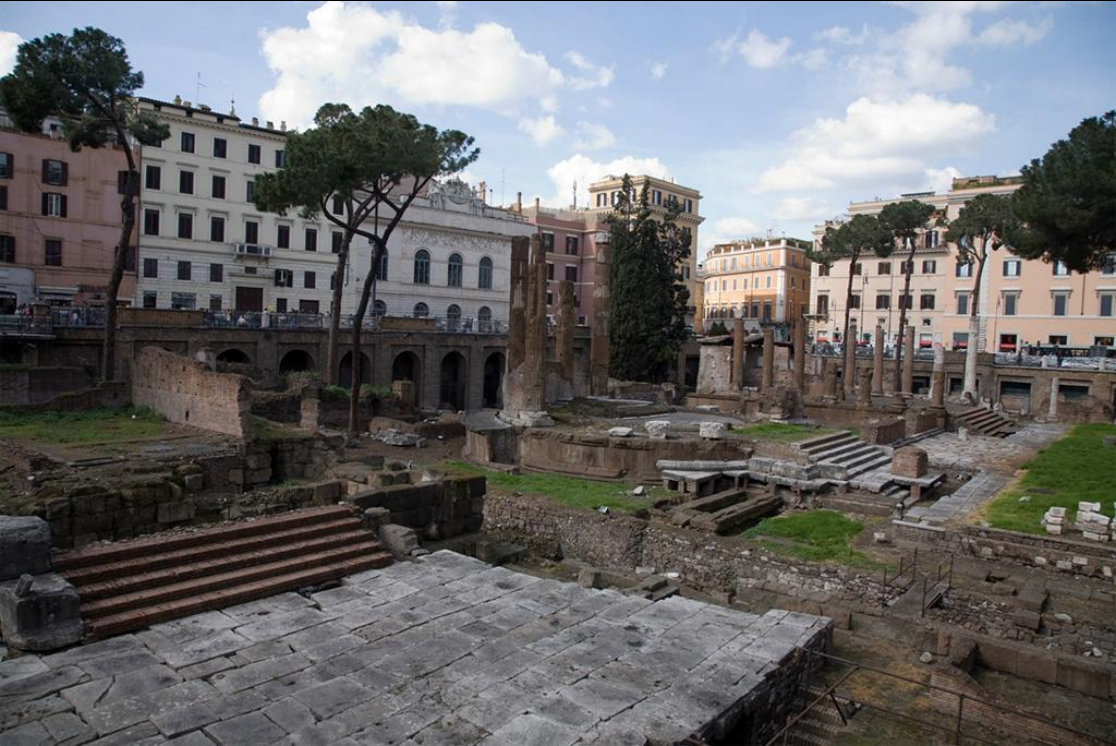
Area Sacra del Largo Argentina (Largo Argentina), Rome,4th-1st c. BCE; located in Southern Campus Martius, contains four Republican temples (A, B, C, D)

Temple of Fortuna Huiusce Diei (the Fortune of This Day); Temple B in the Largo Argentina, built in 101 BC by Quintus Lutatius Catulus after the Battle of Vercellae
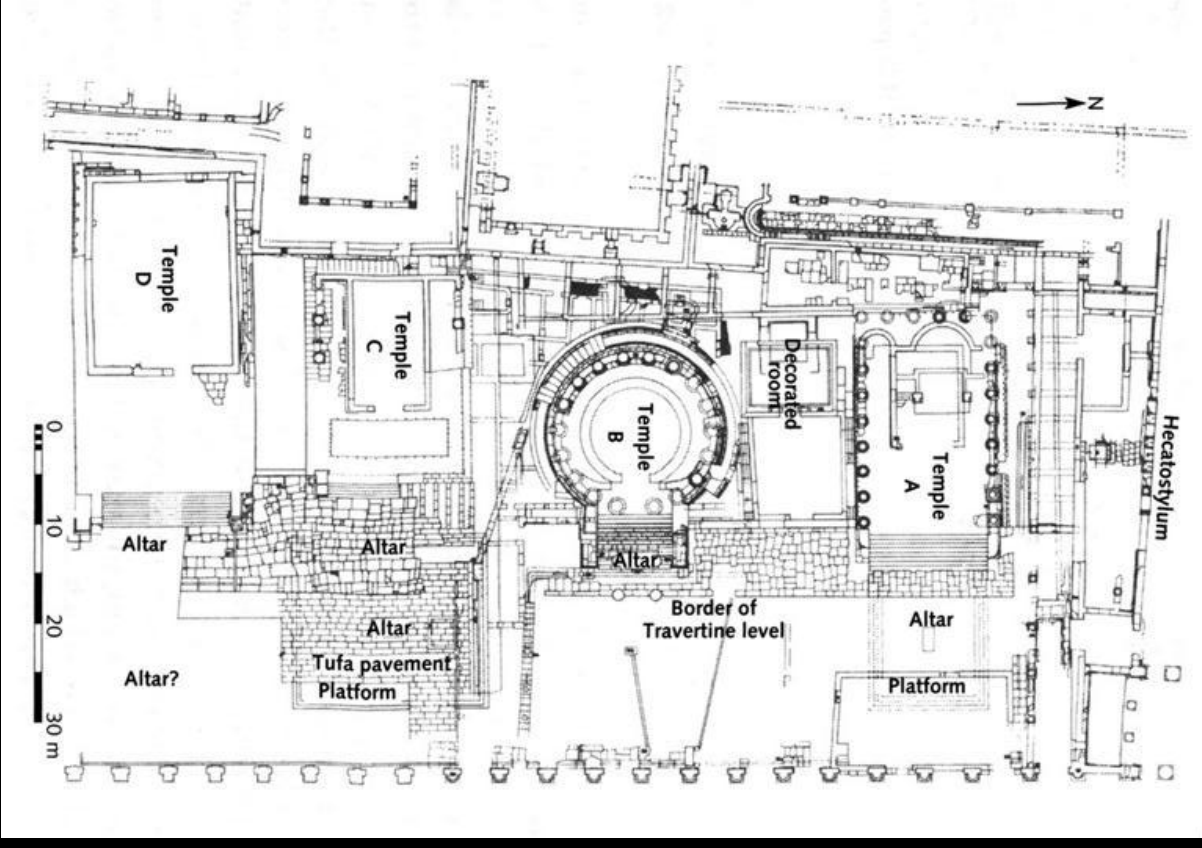
plan of Area Sacra del Largo Argentina (Largo Argentina), Rome,4th-1st c. BCE; located in Southern Campus Martius, contains four Republican temples (A, B, C, D)
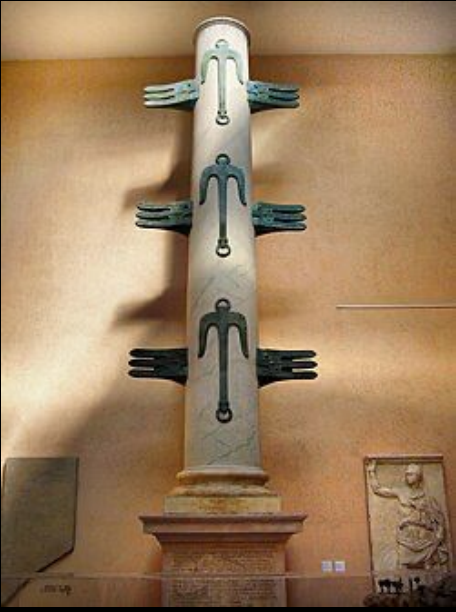
Rostral Column of Gaius Duilius, c. 260 BCE, celebrating the naval victory over the Carthaginians at the Battle of Mylae
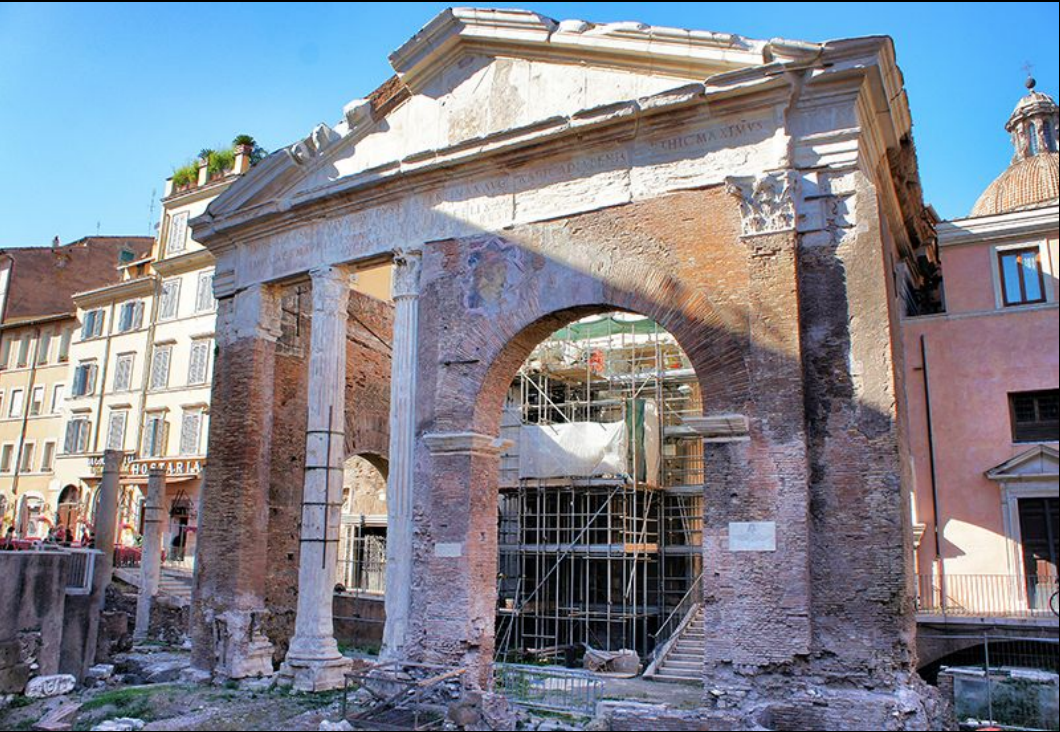
Porticus Metelli / Porticus Octaviae (Portico of Metellus/Octavian) 1st c. BCE, Southern Campus Martius, built by Quintus Caecilius Metellus Macedonicus after victory at Scarpheia during the Achaean War; contained the Temples of Juno Regina and Jupiter Stator
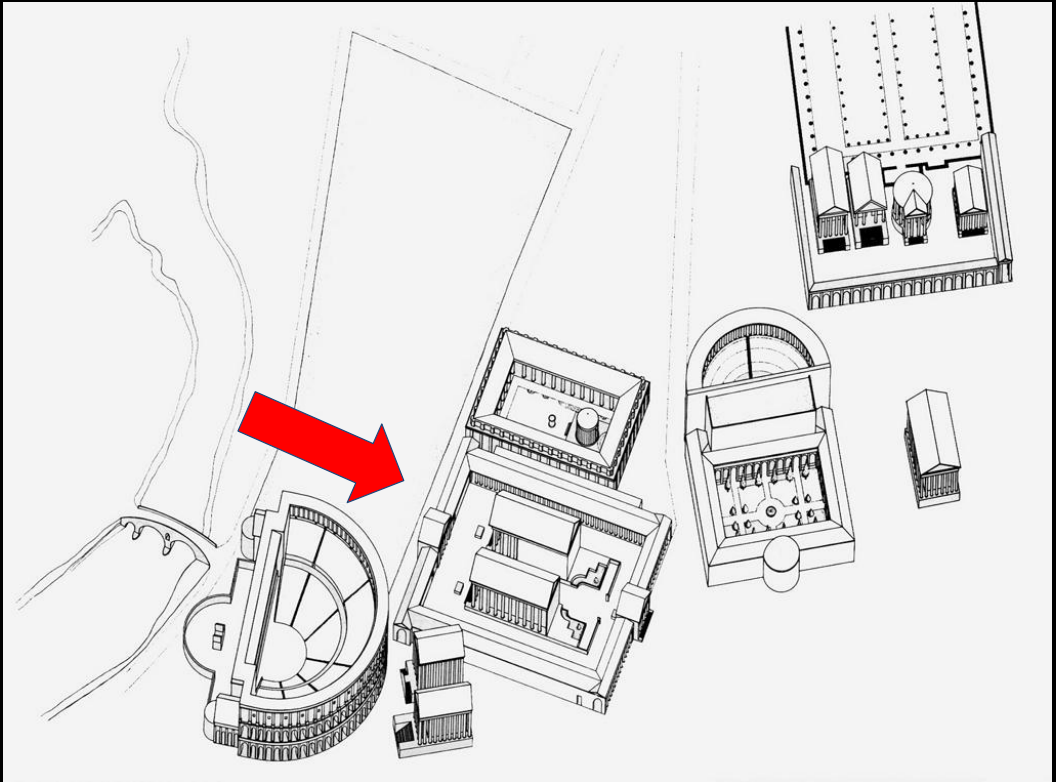
Porticus Metelli / Porticus Octaviae (Portico of Metellus/Octavian) 1st c. BCE, Southern Campus Martius, built by Quintus Caecilius Metellus Macedonicus after victory at Scarpheia during the Achaean War; contained the Temples of Juno Regina and Jupiter Stator
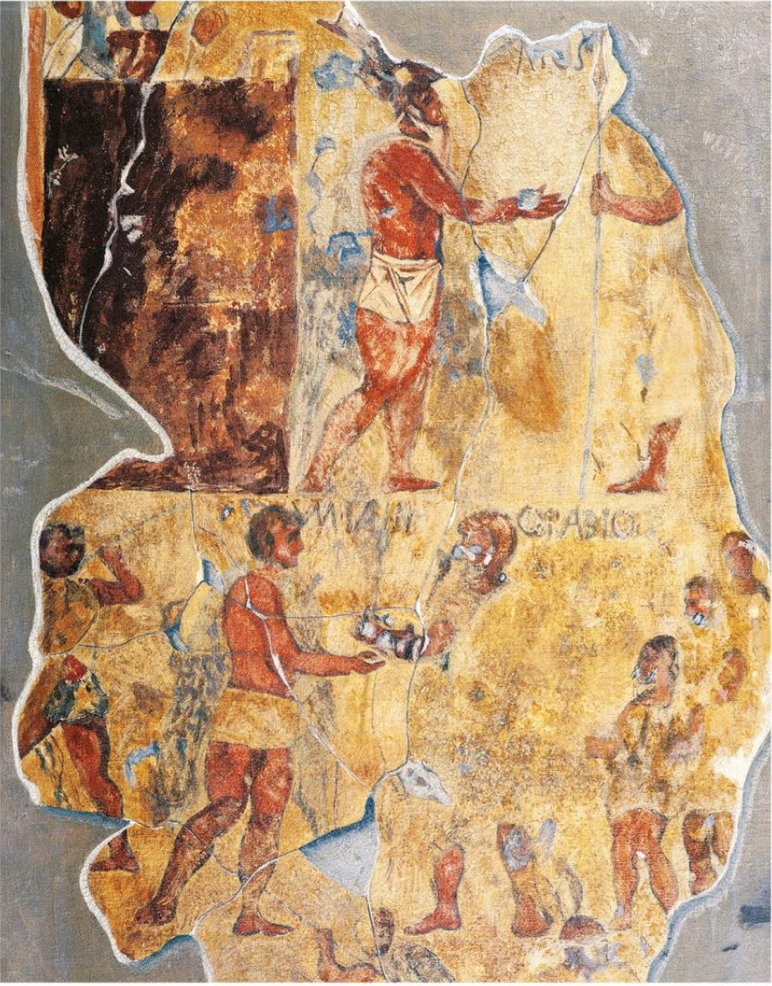
Fresco from Tomb of Quintus Fabius, Rome, on the Esquiline Hill, 3rd c. BCE; example of a Triumphal Painting depicting a Roman victory
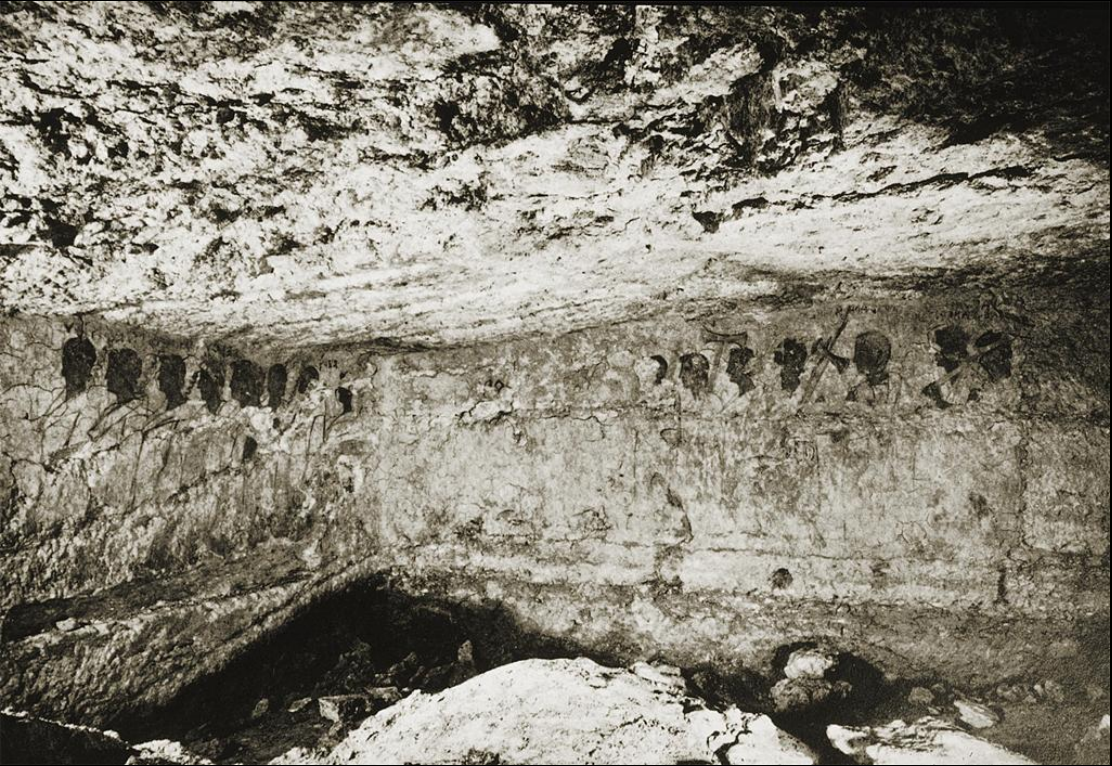
Procession Scene, Tomb of the Typhon, Tarquinia, 2nd c. BCE; example of Roman narrative strategy

Procession Scene, Tomb of the Typhon, Tarquinia, 2nd c. BCE; example of Roman narrative strategy

Monument of Aemilius Paullus, in the Sanctuary of Apollo at Delphi, 168 BCE, taken from the king of Macedonia, Perses, to commemorate Aemilius’ victory; marble pillar with a relief frieze, bronze horse and rider on top
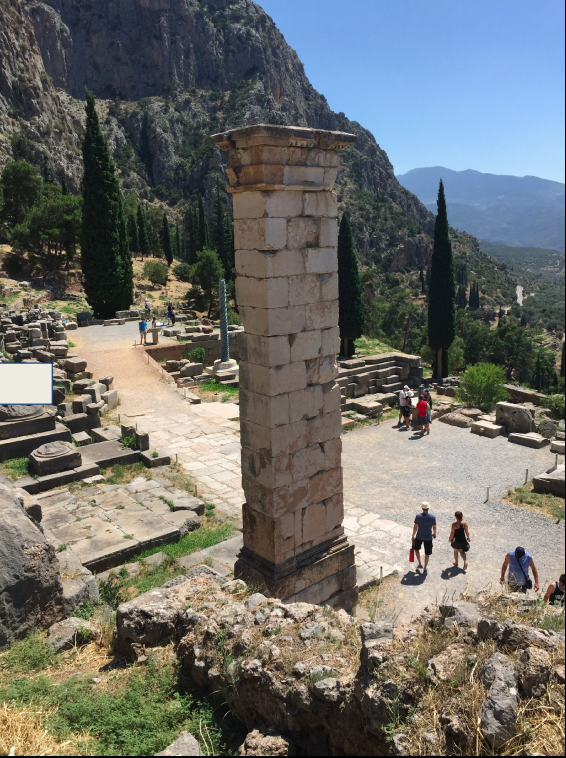
Monument of Aemilius Paullus, in the Sanctuary of Apollo at Delphi, 168 BCE, taken from the king of Macedonia, Perses, to commemorate Aemilius’ victory; marble pillar with a relief frieze, bronze horse and rider on top; inscription reads “Lucius Aemelius, son of Lucius, Imperator, took it from King Perseus and the Macedonians”
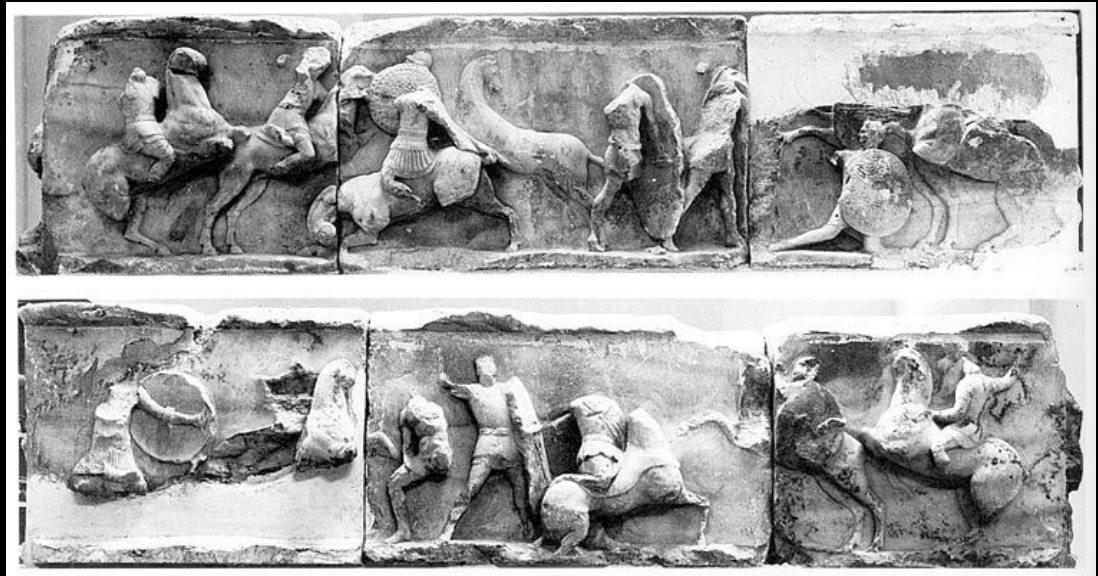
Sculpted Relief Frieze: Battle between Romans and Macedonians, Marble; located on the Monument of Aemilius Paullus; establishing the Romans’ permanent presence in Greece; has an interest in specificity and individuality––HIS battle

Bronze head from Delos (Greece), 100 BCE, bronze; features such as deep-set eyes, expressive eyebrows, and wrinkles express realism; drawn from real-life, suggestive of the individual
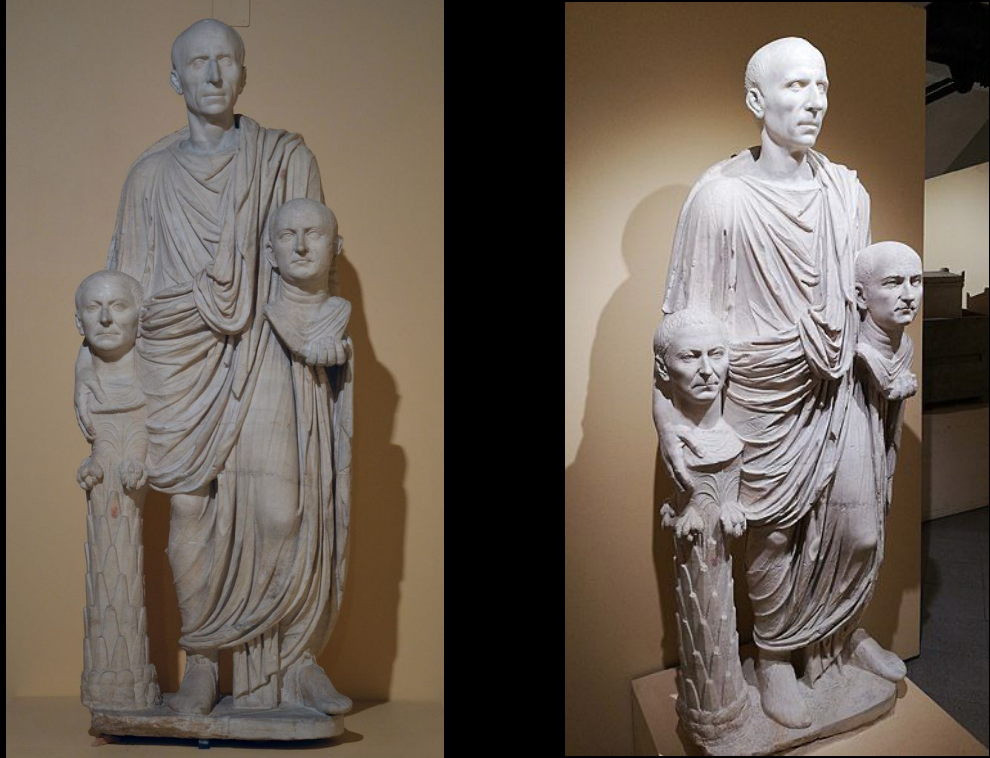
Barberini Togatus, “togate figure,” marble, 1st c. CE; Roman senator displaying busts of his ancestors––celebrating family lineage, showing likeness between family members as if he is their physical and political reincarnation; representation of the funerary practice of wax ancestor masks
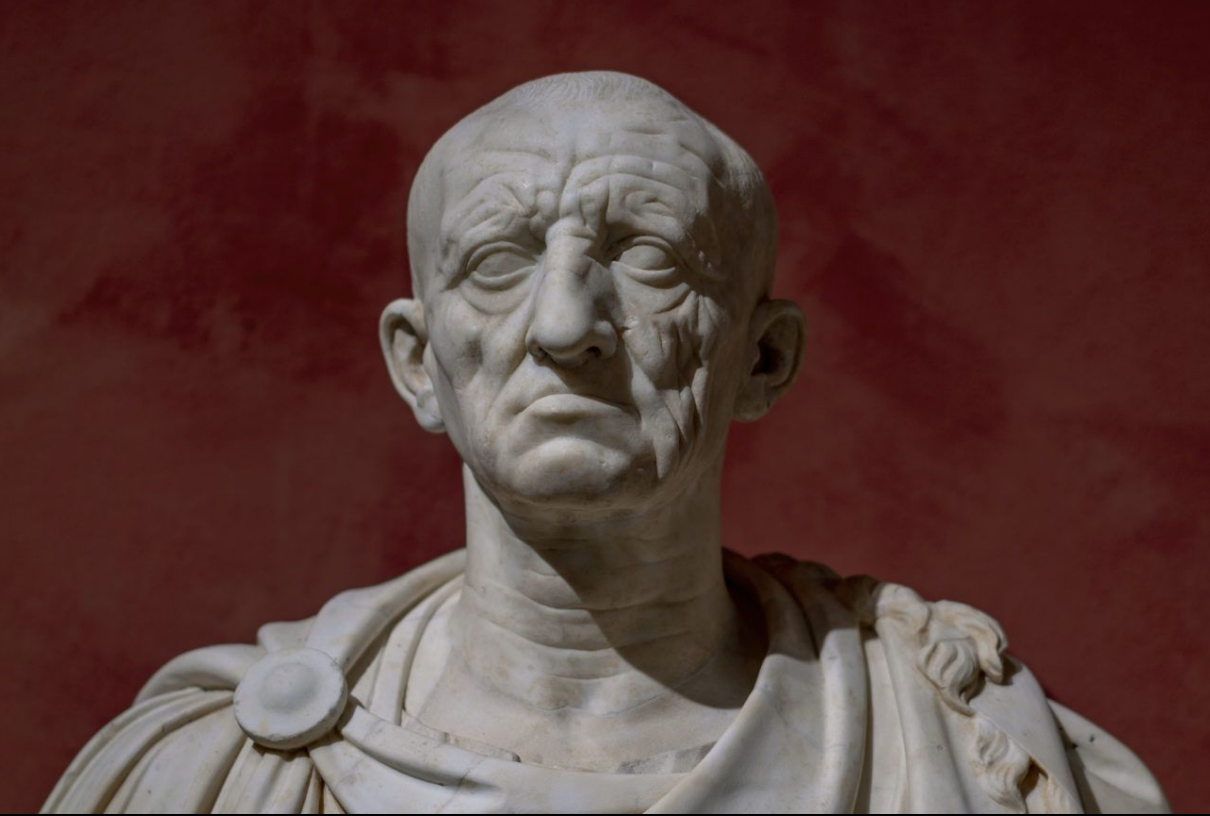
Head of Roman Patrician from Otricoli, c. 75-50 BCE, marble. Example of veristic Republican portraiture; time and hard life (dedicated to Rome) has worn this figure down, as if he is declaring “this is who I am and what I did on behalf of the state”
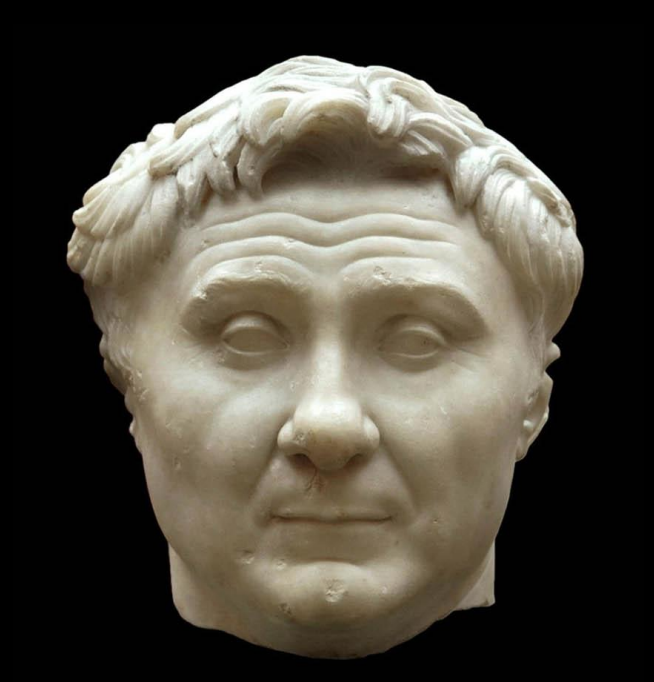
Head of Pompey the Great, c. 60-50 BCE, marble. Longer hairstyle emblematic of Alexander the Great (with anastole); veristic features such as forehead wrinkles, prominent chin, deep-set eyes
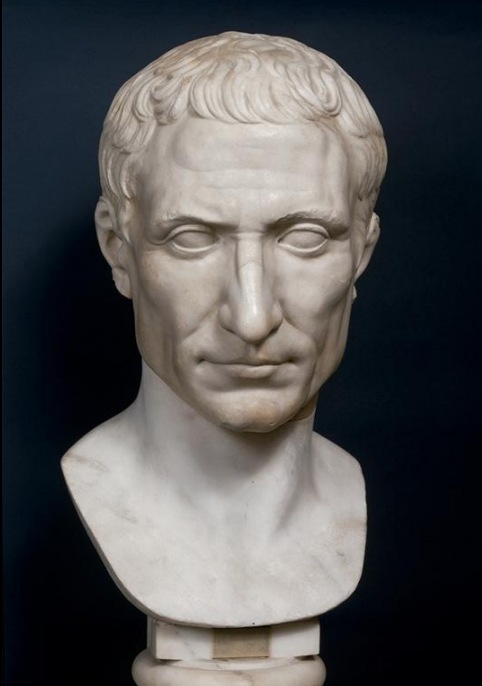
Head of Julius Caesar (“Chiaramonti Head”), 1st c. BCE, marble; portrait in the old verastic Republican style
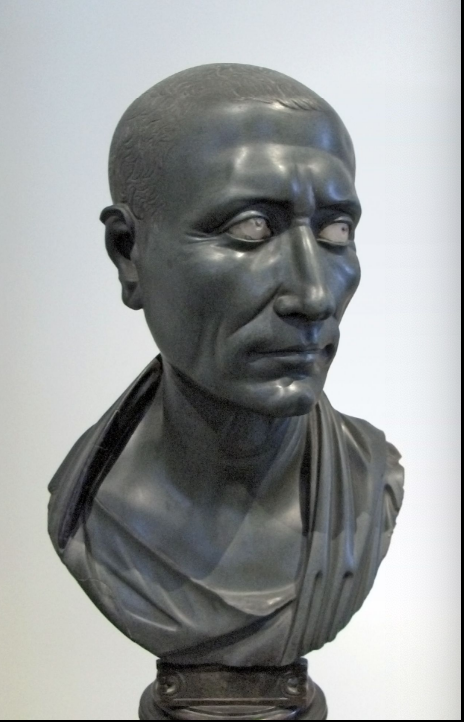
“Green Caesar,” 1st c. CE, greywacke (dark sandstone). Realistic/Verastic features communicate gravitas/dignitas of old age/experience
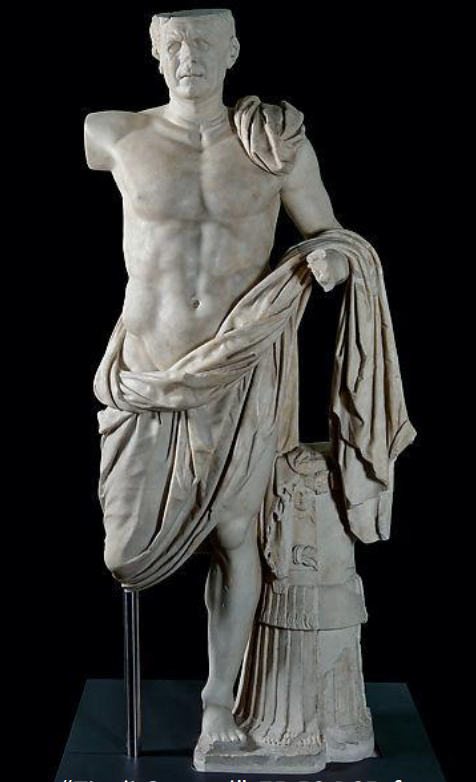
Tivoli General, 75-50 BCE, from Sanctuary of Hercules, Tivoli, marble. Verastic head on an idealized body, depicting a youthful, strong, athletic body but not totally naked, to preserve dignitas. Example of Roman generals looking back at Hellenistic statues of kings.
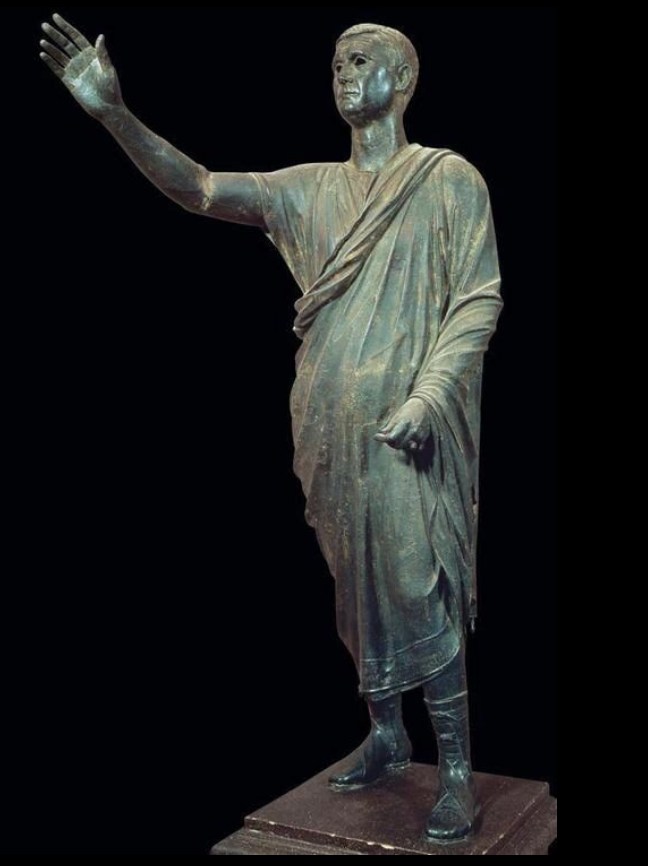
Aulus Metellus / L’Arringatore (The Orator), early 1st c. BCE, Cortona, Italy, bronze. Commissioned for Aule Metelle by the community. Displays use of “appendage aesthetic,” exaggerated size of the hand and arm are suited for a specific perspective point. Comes from a time when Etruria was under Roman control. Fully clothed to depict the virtue of modesty.
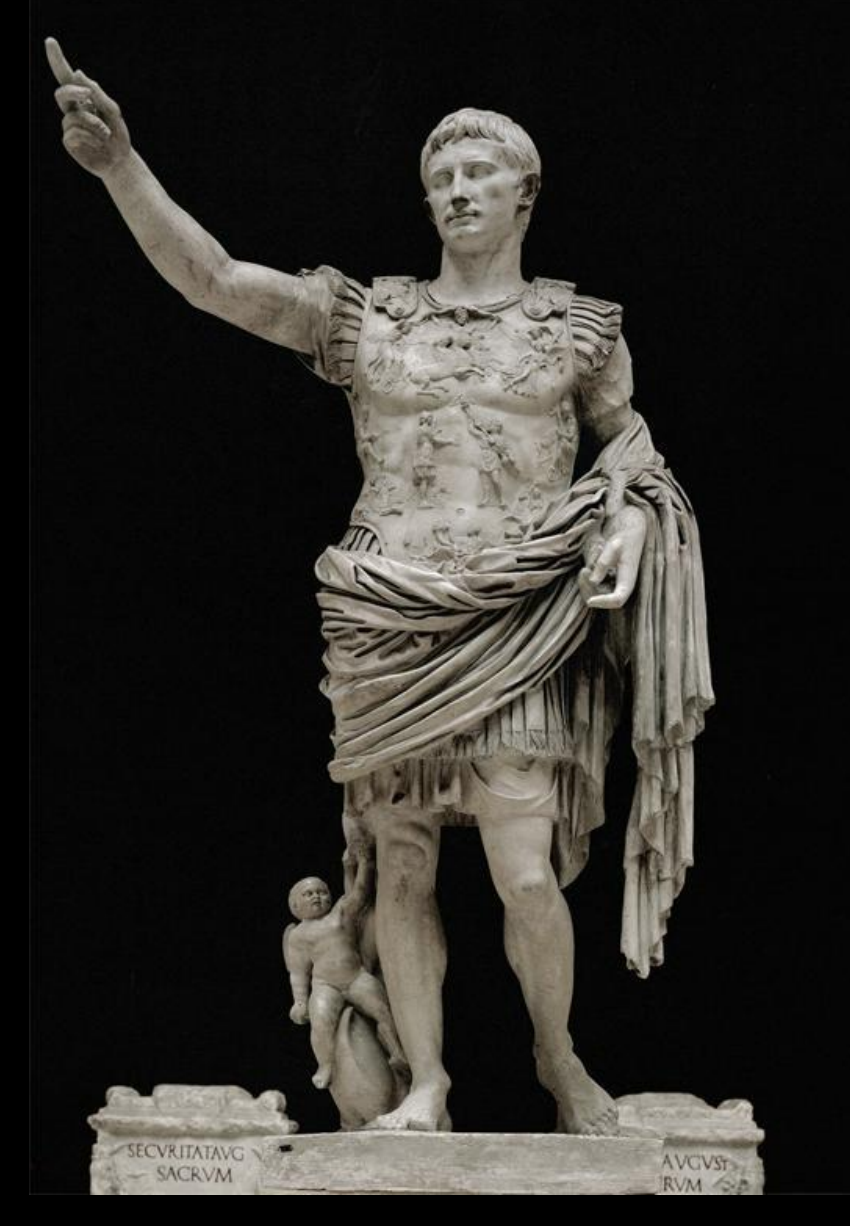
Augustus of Prima Porta, 1st c. CE, marble. Appendage aesthetic / pose based on the Greek Doryphoros statue (contrapposto), refferring back to ideals of the Greek Classical and Hellenistic periods as well as heroes such as Alexander the Great; conservative dress in battle-garb (wearing the aegis) depicting his role as imperator; communicating calmness, unmoved; Augustus is always depicted as young and unchanging––idealism characteristic of a shift in portraiture with the end of the Republic; Cupid at his feet alludes to his mythical connection to Venus by way of Julius Caesar
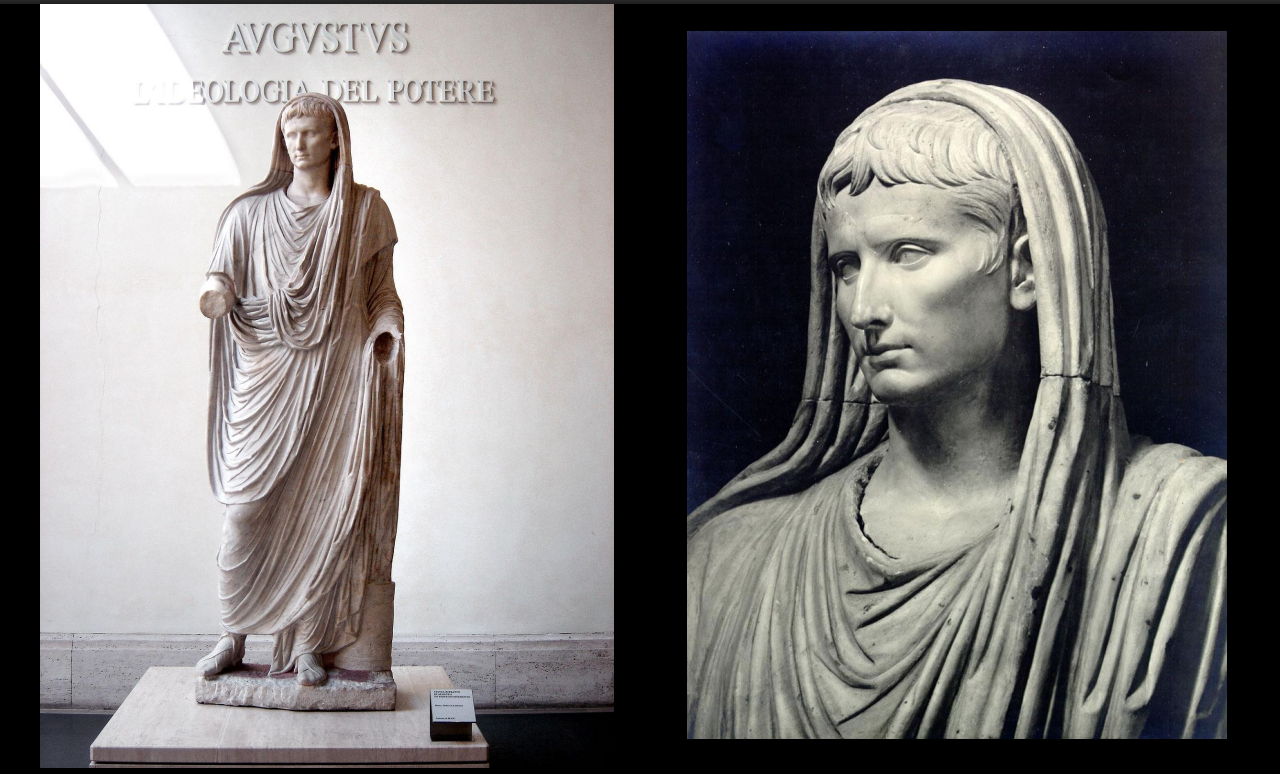
Augustus as “pontifex maximus” (chief priest), after 12 BCE, marble, found in the Via Labicana, Rome. Capite velato.
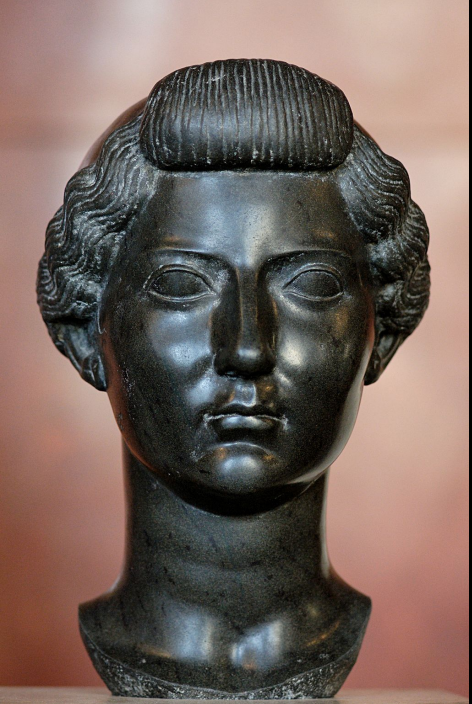
Portrait of Livia (Augustus’ wife), c. 31 BCE, Egyptian basanite. Wearing a nodus - hairstyle in 3 sections. Aged features counterbalance the break with tradition being done with Augustus’ idealized portraiture.
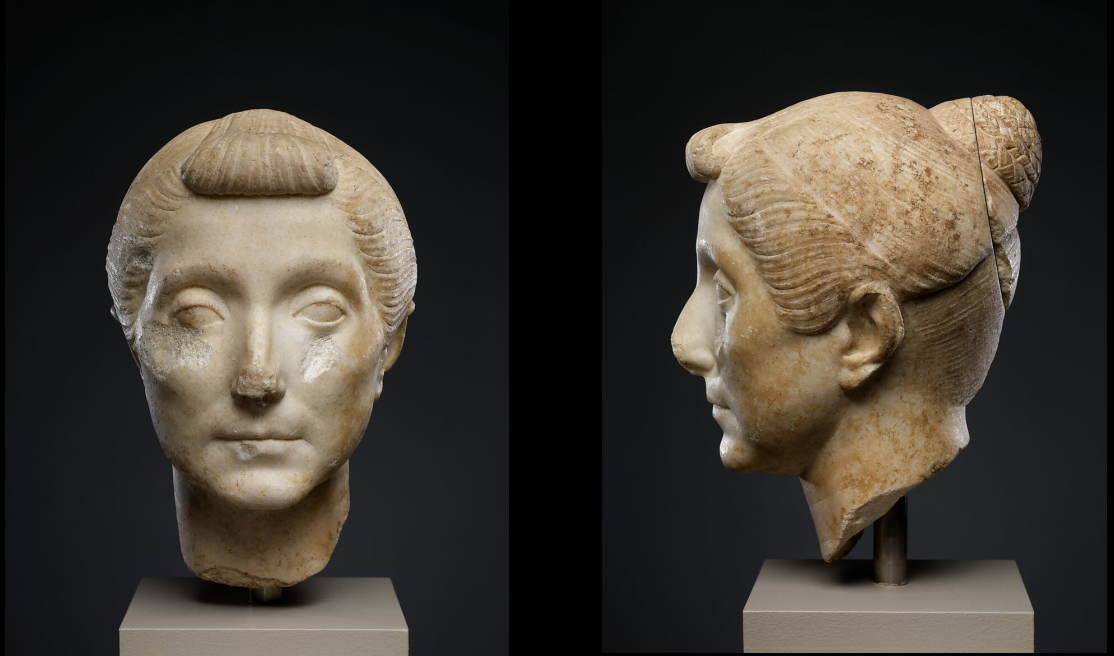
Veristic Republican portrait of “Elderly Woman,” 40-20 BCE, marble.
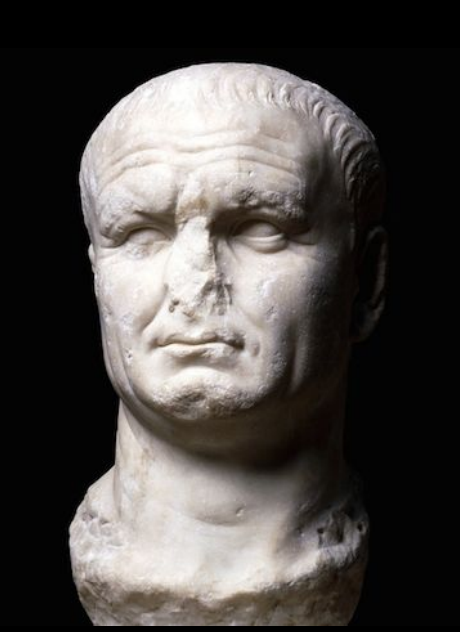
Vespasian, 70-80 CE, from Carthage, marble. Veristic - consciously choosing the Republican style of portraiture, showing his practical, military-oriented values
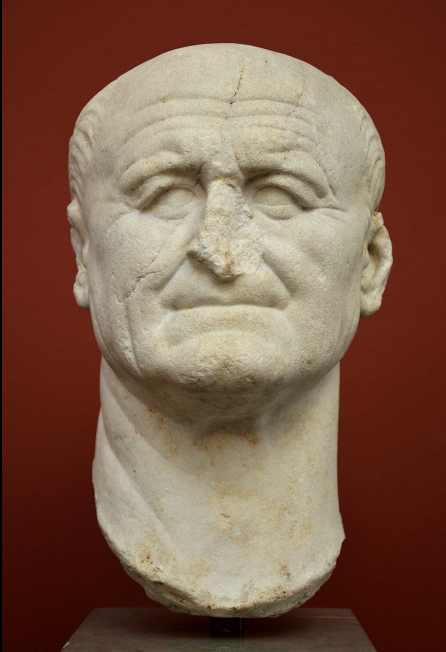
Vespasian, c. 70 CE, marble. Veristic - consciously choosing the Republican style of portraiture, showing his practical, military-oriented values
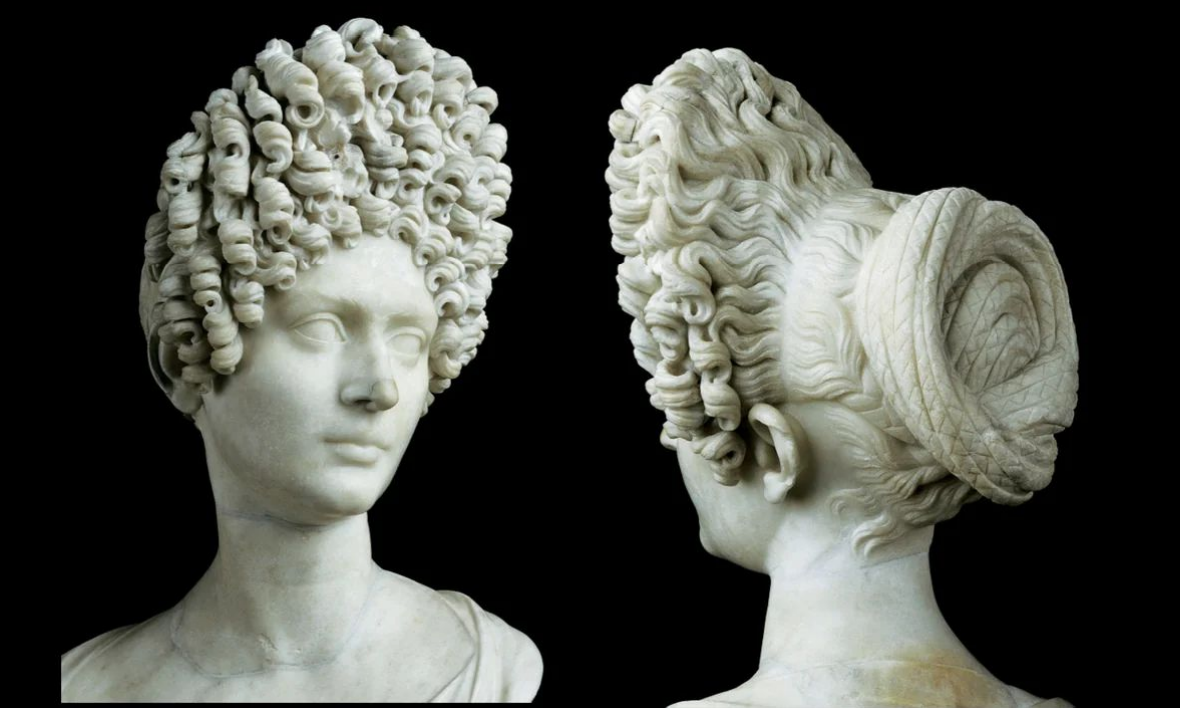
Portrait of a Flavian Woman (“Fonseca Bust”), Rome, early 2nd c. CE, marble. Idealistic style contrasts that of the portraits of Vespasian.

Portrait of Julia Domna, Ostia, Italy, c. 203-217 CE, marble. Elaborate wig, serene face; in conversation with portraits of her son, Emperor Caracalla, which were severe, brutish, and gladiatorial.
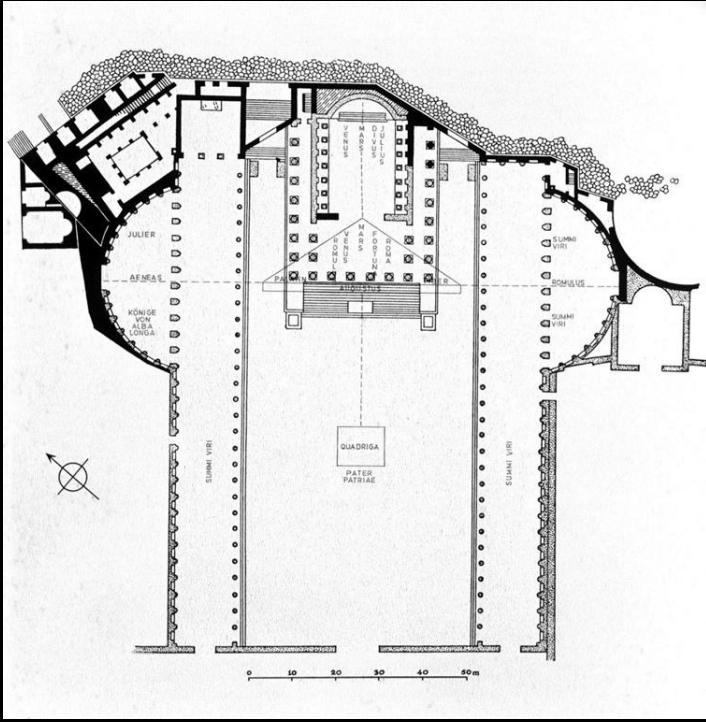
Forum of Augustus (Forum Augustum), inaugurated 2 BCE. Built as part of Augustus’ project to rebuild Rome and establish the new Augustan empire; contains the Temple of Mars Ultor (Mars the Avenger) which Augustus vowed to build at the Battle of Philippi (42 BCE) in exchange for the avenging of Julius Caesar. Sculptures in the exedrae depict Romulus and Aeneas, associating Augustus with Rome’s mythical founders.
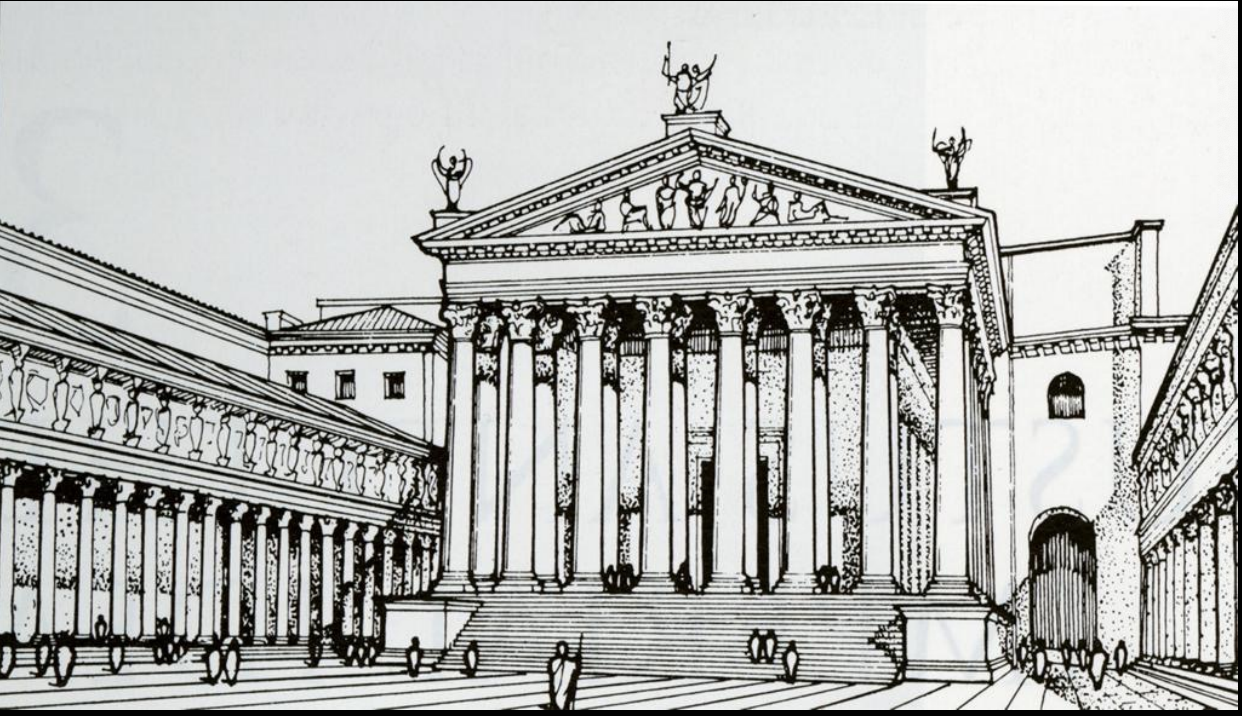
Temple of Mars Ultor, “Mars the Avenger,” inaugurated 2 BCE, located in the Forum Augustum. Peripteral on all sides except the back; Corinthian columns; triangular pediment above the roof with sculptures.
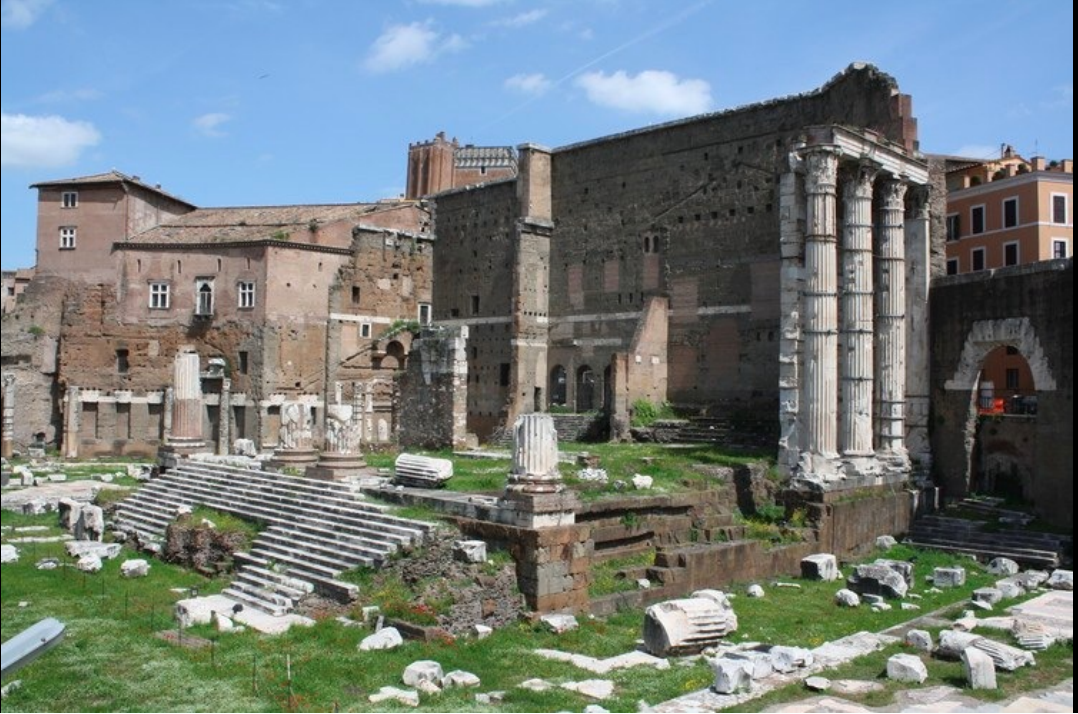
Temple of Mars Ultor, “Mars the Avenger,” inaugurated 2 BCE, located in the Forum Augustum. Peripteral on all sides except the back; Corinthian columns; triangular pediment above the roof with sculptures.
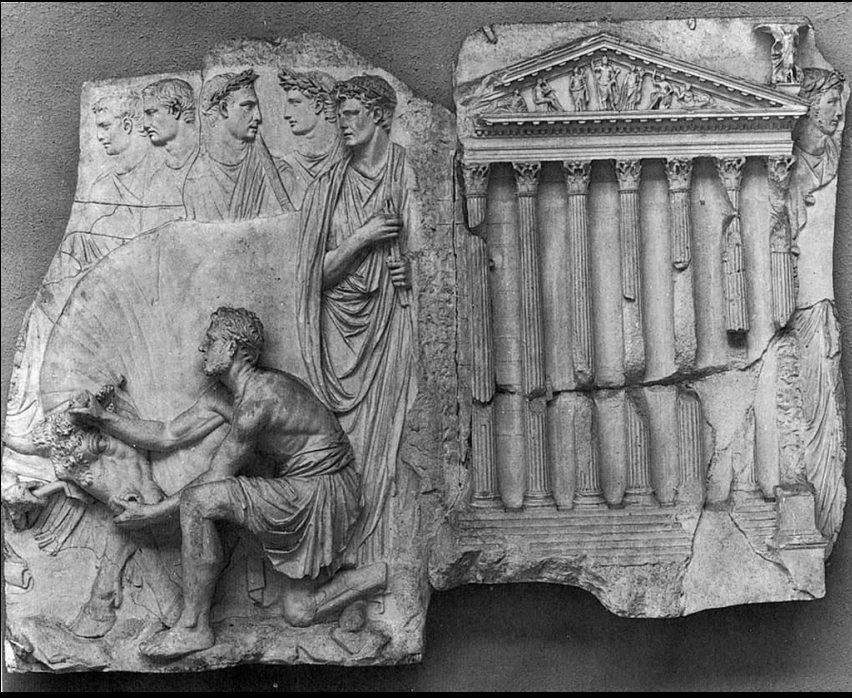
Evidence for the Pedimental Sculpture of the Temple of Mars Ultor: Medici Relief, 50 CE, Villa Medici, Rome. Central figure of Mars, flanked by Venus, Fortuna, and personifications of the Palatine Hill and Father Tiber.
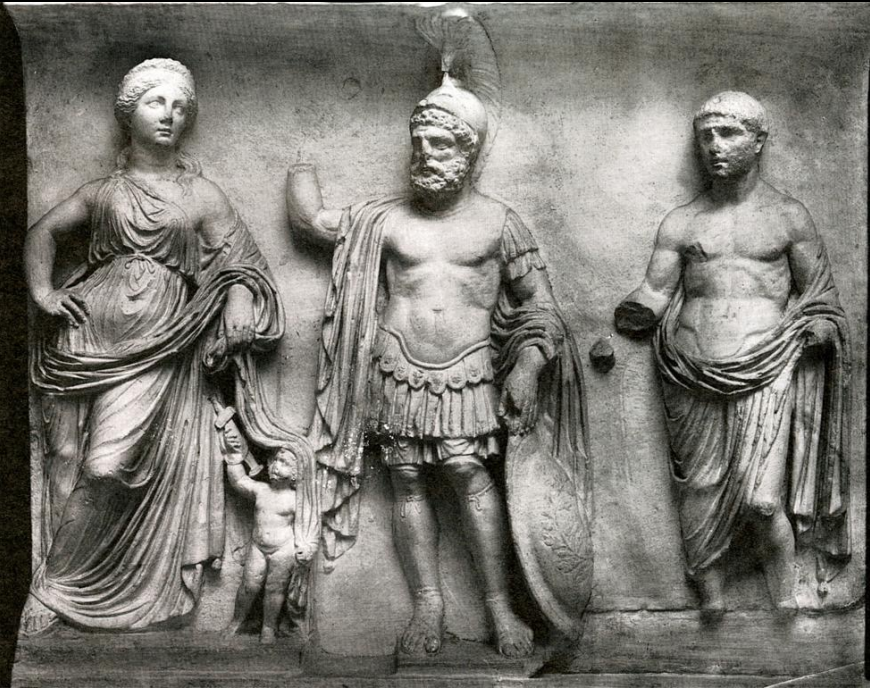
Evidence for the Cult Statues inside the Temple of Mars Ultor: The Algiers Relief, 1st c. CE. Depicts Venus, Mars, and Julius Caesar, a “family portrait” of sorts, connecting Augustus to Julius Caesar, who was supposedly descended from Venus via Aeneas. Sanitizes Mars as the god of war by portraying him as a father figure and placing him outside of the Campus Martius. The “exploitation of the mythical sphere.”
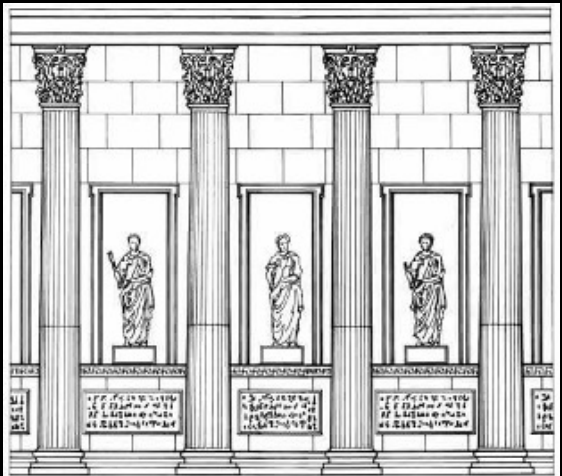
Statues of the Summi Viri (Great Men) in the Forum of Augustus.
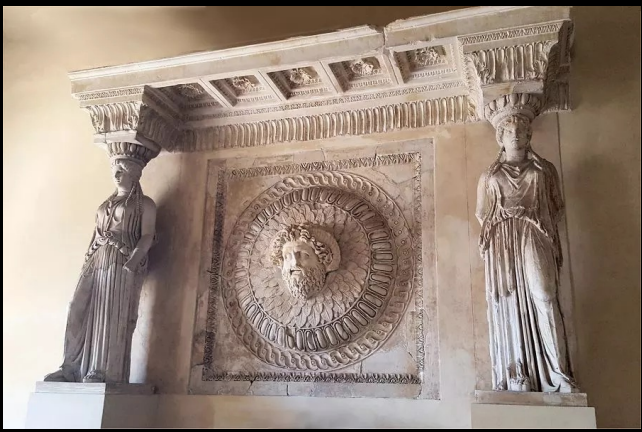
Atticy Story of the Portico of the Forum of Augustus, Caryatids flanking shield with head of Zeus Ammon